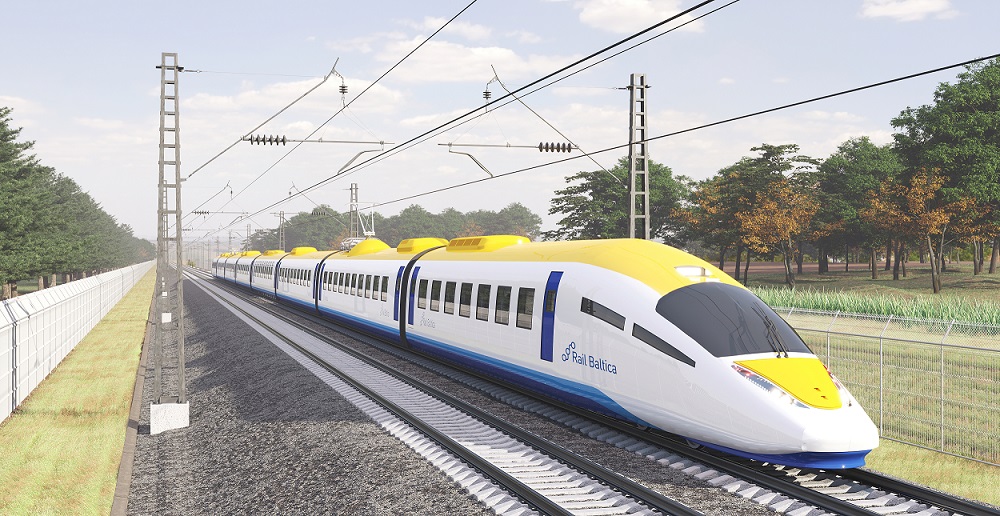The idea of Rail Baltica, a railway connecting the Baltic States with Europe, traces back to the restoration of independence of the Baltic States in the 1990s. It represented the region’s determination to reclaim its historical ties and pave the way for improved connectivity and economic growth. Despite challenges and shifting political landscapes, the idea of such a project persisted for four decades.
 Today, as Rail Baltica prepares to become a tangible reality, breathing new life into the region’s transportation infrastructure and aligning with sustainability goals, Arenijus Jackus, Head of Rail Baltica Strategy and Business Development at LTG Infra and member of RB Rail AS Supervisory Board, offers a perspective on the project’s birth and development through the lens of Lithuania.
Today, as Rail Baltica prepares to become a tangible reality, breathing new life into the region’s transportation infrastructure and aligning with sustainability goals, Arenijus Jackus, Head of Rail Baltica Strategy and Business Development at LTG Infra and member of RB Rail AS Supervisory Board, offers a perspective on the project’s birth and development through the lens of Lithuania.
Turbulent Times and Changing Gauges: From 1524mm to 1435mm and Back
The history of railway gauges in Lithuania adds an interesting perspective to the development of Rail Baltica. In 1851, the Russian Empire initiated the construction of the S. Petersburg–Warsaw railway with a gauge of 1524mm. However, during World War I in 1915, the German Army, as occupiers, replaced a significant portion of the tracks with a gauge of 1435mm. After the war, Lithuanian Railways developed a complete network based on the 1435mm gauge. However, the railway gauge faced further changes due to the shifts in occupiers.
- In 1940, with the occupation by the Soviet Union, most of the railway network’s gauge was changed back to 1524mm. However, during the Nazi occupation in 1941, the gauge was once again modified to 1435mm. The turbulent times continued as the Soviets regained control in 1944, and the gauge was changed back to 1524mm, later transitioning to the 1520mm gauge.
- In 1992, regular consultations commenced between the transport ministers of Lithuania, Latvia, and Estonia, marking an important milestone in their collaborative efforts. As a result, the Council of Transport Ministers of the Baltic States was established, facilitating discussions on drafts of international documents and fostering coordination of common positions. In that same year, ministers from the three Baltic states made their inaugural participation in the Conference of European Transport Ministers, further solidifying their engagement on a broader scale.
- In 1994, the National Transport Development Program received approval, emphasizing the significance of developing a European standard gauge railway and integrating it into the larger European transport system. The recognition of this importance extended beyond regional cooperation. At the ETM conference held in Crete (Greece) that year, the Ministers of the Baltic States were invited, underlining the growing recognition of their role in the transportation landscape. Furthermore, during this conference, international transport corridors I and IX, along with their associated branches, were acknowledged as top priorities within the Central and Eastern European transport network. This recognition highlighted the strategic importance of these corridors and their potential to enhance connectivity and facilitate efficient transportation throughout the region.
- In 2004, the Rail Baltica project gained recognition as Priority Project No. 27 on the list adopted by the European Parliament and the Council of Europe. The involvement and support of Lithuania
played a vital role in the project’s advancement. - In 2005, Estonia, Latvia, Poland, and Lithuania demonstrated their commitment to the Rail Baltica project by submitting coordinated and agreed applications. These applications were successful in securing funding from the TEN-T Fund, which provided crucial financial support for the project.
 The implementation of Rail Baltica 1, in line with various EC Decisions and Lithuania’s parliament’s resolutions, encompassed several key elements. This included the reconstruction of the existing 1520 mm gauge and the construction of second tracks to enhance capacity. Additionally, the project involved the reconstruction of the 1435 mm European gauge, the establishment of a 1435/1520 mm dual gauge, and the construction of a new 1435 mm gauge alongside the existing 1520 mm gauge. Furthermore, a comprehensive feasibility study conducted by AECOM, known as “Rail Baltica 2,” focused on the development of a separate line with a 1435 mm European gauge. The findings of this study received approval from the Prime Ministers and Ministers of Transport of the Baltic states and gained support from the European Commission, further cementing the project’s importance and viability.
The implementation of Rail Baltica 1, in line with various EC Decisions and Lithuania’s parliament’s resolutions, encompassed several key elements. This included the reconstruction of the existing 1520 mm gauge and the construction of second tracks to enhance capacity. Additionally, the project involved the reconstruction of the 1435 mm European gauge, the establishment of a 1435/1520 mm dual gauge, and the construction of a new 1435 mm gauge alongside the existing 1520 mm gauge. Furthermore, a comprehensive feasibility study conducted by AECOM, known as “Rail Baltica 2,” focused on the development of a separate line with a 1435 mm European gauge. The findings of this study received approval from the Prime Ministers and Ministers of Transport of the Baltic states and gained support from the European Commission, further cementing the project’s importance and viability.
Transforming Transportation and Paving the Way for a Sustainable Future
“The ambitious environmental goals set by the European Union for 2050 have significant implications for the transportation sector. The EU aims to achieve a remarkable 60% reduction in transport-related greenhouse gas emissions compared to 1990 levels. To accomplish this, several specific targets have been outlined. The EU envisions a future where cities no longer rely on conventionally fueled cars, promoting the adoption of sustainable and low-carbon alternatives.”
Emphasizing the importance of rail, the EU envisions most of the medium-distance travel being completed by this mode, while striving for the completion of a comprehensive European high-speed rail network. Furthermore, the EU seeks to establish a fully integrated trans-European transport network and make significant progress toward zero road transport fatalities, emphasizing the importance of safety and efficiency in transportation systems.
“Today, Rail Baltica holds a prominent position on the European Union’s transport priority list as it serves as a vital link in the North Sea-Baltic corridor, connecting the north-western and northeastern regions of the European Union by 2030. Additionally, Rail Baltica’s technical specifications make it highly relevant for military mobility purposes.”
In December 2022, the Transport, Telecommunications, and Energy Council adopted its position on the draft regulation for the Union guidelines for the development of the trans-European transport network (TEN-T). In this regard, Member States have proposed the inclusion of Rail Baltica in the Baltic Sea-Black Sea-Aegean Sea European Transport Corridor. This implies a potential future connection of Rail Baltica to Ukraine and Moldova.
For more detailed insight into the history of railways watch Arenijus Jackus’ lecture here.
